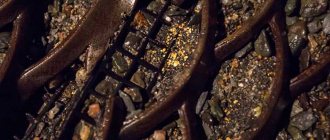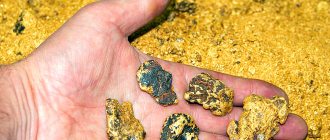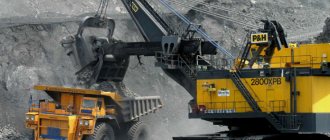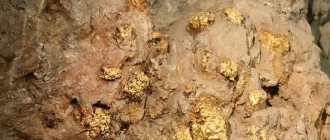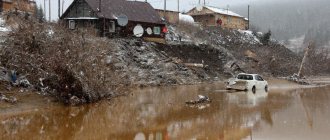Gold has been mined in Russia for more than 200 years, and taking into account geological features, all the main deposits are concentrated beyond the Urals. 95% of all precious metal mined comes from 15 regions. Gold mining in the Trans-Baikal Territory is not record-breaking in volume. Statistically, there are more profitable areas. However, unlike other competitive regions, there are significantly more alluvial deposits here - 33 versus 9 ore deposits.
How did mining begin in Transbaikalia?
The first gold in the Trans-Baikal region was mined as a by-product in 1702, when the Nerchinskoye silver ore deposit was explored. Two years later (1704), the construction of the Nerchinsk smelter was completed. From three tons of smelted ore containing silver, it was possible to extract approximately 16 kg of gold.
The Carian placer, discovered in 1838, marked the beginning of the “gold rush” of Transbaikalia. From this point on, deposits of placer and bedrock gold began to be found throughout the region. The date May 31, 1843 went down in history. On this day, private individuals in the western part of Transbaikalia were allowed to work in the mines. In Eastern Transbaikalia this became possible only 20 years later.
The advantage of new technologies
The main reserves of the precious metal (about 80%) in the region are concentrated in ore-type deposits. But the main mining (like 100-150 years ago) is still carried out in placers. Previously, prospectors used only a pick, a shovel and a sieve; later, they used dredges of the most primitive type. But the deposits were virtually untouched; very large nuggets were often found almost on the surface.
Today the situation has changed, in order to find gold, you have to wash tons of gold-bearing sands. To carry out the work, modern dredges with large-volume buckets (the most common are 80 and 250 liters), specialized washing devices, earth-moving and automotive equipment are used. The large capacity and technological effectiveness of the process make it possible to extract gold deep into the subsoil and develop deposits classified as technogenic (i.e. those that have already been developed and/or abandoned).
Dynamics of gold mining in the region
2014 was a record year for gold mining and production for Russia - 272 tons. Which brought the country to second position in the world after China.
However, already in the next year, 2015, the gold production rate began to decline. The amount of extracted aurum also decreased in the Trans-Baikal Territory. Two enterprises were able to increase the amount of gold mined. Volumes increased at the Novo-Shirokinsky deposits, and in the work of Mangazeya, which in 2015 broke its previous record by 200%, producing 1054 kg of precious metal (versus 560 kg last year).
However, if we compare the data, since 2004, development and production volumes have been growing.
Production dynamics in the region from 2004 to 2015.
| 2004 | 2005 | 2006 | 2007 | 2008 | 2009 | 2010 | 2011 | 2012 | 2013 | 2014 | 2015 |
| 6.4 t | 6.4 t | 6.4 t | 6.3 t | 5.7 t | 5.6 t | 5.6 t | 7.8 t | 8.3 t | 11.7t | 12.3t | 11.3t |
The placer mining season began earlier than usual, but in August 2015, just over 6.5 tons of gold were mined. The above companies engaged in the development of primary deposits became the leaders.
However, there are plans to increase the volume of gold mining. The bet is placed specifically on ore deposits, as they are more profitable. The previous governor stated that by the 20s the gold mining industry would reach a level of 20 tons. This is quite realistic, considering that over 12 tons were mined in 2021.
Companies engaged in indigenous development became record holders.
| Company | Indicator for 2021 |
| Novo-Shirokinsky mine | 2000 kg |
| Alexandrovsky mine | 1300 kg |
| Mangazeya Mining | 850 kg |
It is planned to increase the volume of ore processing at the Novo-Shirokinsky and Darasunsky deposits, and in the future to increase the amount of raw material processing at the Pogromninsky, Ildikansky and Bogomolovsky deposits. In addition, projects for launching development at other fields (Taseevskoye, Klyuchevskoye, Andryushkinskoye, Verkhne-Aliinskoye, and others) are being completed and prepared.
It is gold mining that is planned to give impetus to the overall economic development of the entire region.
How modern placers of Transbaikalia are developed
Such areas are most often mined by small teams of miners, rather than gold mining giants. The work is carried out using the flushing method. Before the start of the season, large-scale preparations are carried out: cutting down forests, clearing roads, laying a canal to divert the river bed. With the onset of a thaw, stripping is done, i.e. With the help of excavators and bulldozers, several meters of rock hiding the gold-bearing sands are removed.
If the rock is not suitable for use in the construction industry, it is taken to dumps. The layer with minerals (there may be lead and silver) is washed. For this purpose, water from a designated riverbed and special equipment are used. The processed rock is loaded into the hopper of the industrial device, and under the influence of water pressure, metal remains on the stencil. It is then sent to a refinery where it is purified of impurities and turned into pure gold.
Prospects for new fields
According to geological data, there are over 1000 occurrences of the precious metal in the region. This figure includes both gold mining areas and gold-bearing sands. Deposits are also possible at the bottom of Lake Baikal. But to accurately calculate and approve reserves, additional geological exploration work and significant financial resources are required.
The main gold ore deposits of the region
The richest deposits of indigenous gold include:
- Baleyskoe – 40 tons.
- Darasunskoye – 57 tons.
- Talatuiskoye – 57 tons.
- Klyuchevskoye – 58 tons.
- Itakinskoye - 63 tons.
- Taseevskoe -106 t.
It should be taken into account that during the development of areas, reserves can be recalculated upward.
Field map
An approximate estimate of metal reserves in Transbaikalia is approximately 1000 tons. The main deposits are concentrated in the South Daursky, Kariysky, Chikoysky, Baleysky, Kazakovsky, Darasunsky regions. They are known for both ores and placers.
The valleys of the Uryum, Alengui, and Simucha rivers are also rich in placer gold.
The main gold ore deposits of the region
A rough study of the indigenous gold deposits of Transbaikalia showed that in the depths of the region there are about a thousand tons of precious metal. Also on the territory of the historical parts of the Kazakovsky and Darasun regions, as well as along the Uryum River, there are promising deposits of placer gold.
Field map
The most accurate data on gold reserves in the ground are available from deposits that have been developed for more than one decade. First of all, this applies to the Chikoy, South Daur, Baley, Darasun, Mogochin and Kari ore districts.
Soil samples and surface studies confirmed the presence of gold-bearing layers in the valleys of the Alenguy and Simucha rivers. There are also talks about studying other regions of the region.
By whom and how are they mined?
Today, about 50 enterprises are developing gold deposits. Taking into account the potential of the region, there could be more of them. But the unstable economic situation in the country is hindering the development of the mining industry. Abandoned and hard-to-reach deposits are showing great interest from China, which is ready to invest in production.
Mining companies
The largest gold mining companies in the Trans-Baikal Territory include:
- OJSC Novo-Shirokinsky Mine, which has a license agreement for the use of the subsoil of the mine of the same name until 2024.
- , all developed areas of which have an advantageous location near developed infrastructure.
- Uryumkan LLC, which recently issued the rights to use the famous Darasun deposit.
- JSC GRK Zapadnaya, which has operational management of projects throughout Siberia.
The listed enterprises specialize in indigenous gold, are developing steadily and regularly post vacancies at the beginning of the mining season.
Modern realities of indigenous mining
In Transbaikalia, despite a significantly larger number of alluvial deposits, the leadership in the amount of gold mined remains with nine ore developments.
For comparison, when extracting precious metal on rivers using the washing method, the enterprise leading in the industry extracted more than 810 kg, while at the same time, the joint-stock company "Rudnik Aprelkovo" received over 2,400 kg from ore. Why is there such a big difference?
- The main reason lies in the lack of connection to the seasonal regime of rivers. Ore mining continues continuously, without stopping.
- Another advantage is that significant preparation of mining sites is not required on a continuous basis. Enterprises do not incur large unprofitable costs.
- In addition, the ore (depending on the geological origin) contains gold from 3-10 to several hundred grams per ton of rock.
- Mines do not use significant amounts of water for flushing, which does not require the construction of entire systems of dams and settling basins for cleanup.
Nature itself creates enormous inconveniences for the extraction of placer gold. During the work season, rivers may experience floods and, as a result, landslides. As a result, all development is stopped, and a transition to another site is required, which, in turn, is associated with the preparation of documents and permits.
The development of primary deposits does not face such problems.
Therefore, if we compare production statistics from 33 mine deposits and 9 primary deposits, a radically different picture emerges.
In Transbaikalia, the leaders in indigenous mining are five gold mining companies:
- CJSC "Rudnik Aprelkovo" as part of a large. The volumes of mined metal amounted to more than 2400 kg;
- Open joint-stock company "Novo-Shirokinsky Mine" obtains gold from lead-zinc concentrates. For the same 2014, the volume is 2006 kilograms. In addition, the company mines other related metals: silver, cadmium, lead, copper and others;
- “Mangazeya Mining” received 566 kg in 2013, and a year later – over 1000 kg of aurum;
- CJSC GRK "Zapadnaya" has been operating recently - since 2013. A gold extraction factory was built and launched. Production capacity allows producing up to 2 tons per year. The following year, 2014, we received 350 kg;
- “Darasun Mine”, the company is developing one of the richest deposits, 317 kg were obtained in the same period.
All these enterprises are part of larger companies producing not only in the Baikal region, but also in other regions of Russia.
According to the general director of the Uryum LLC enterprise, Vladimir Sysoev, which is engaged in the development of placer gold, the future belongs to ore deposits. The mines are gradually being depleted, and only capital investments in radical developments will be able to bring gold mining in Transbaikalia to the proper level.
Production volumes
The volumes of precious metals production in the region are consistently high and tend to increase. On average, each placer mining enterprise produces about 500 kg of gold per year. The total volume of valuable resources extracted in Transbaikalia in 2021 amounted to 13.3 tons.
Today, the Trans-Baikal Territory is considered one of the richest regions in Russia in mineral resources. Unfortunately, due to the lack of investment in the required volume, its potential is not developed properly. At the same time, there is a danger of losing part of the national wealth by attracting investors from China and India.
If you found this article useful, share it with your friends on social networks. Subscribe to our news, it will be interesting! See you again!
The fate of a prospector
Such work is not only life-threatening, but also criminally punishable. To mine gold, you need to get a license - only large companies can do this. According to the current legislation in Russia (the process of exploration, mining and sale of gold is regulated by the federal law “On Precious Metals and Precious Stones”), the activities of private miners in the country are prohibited. The ban has been in effect since 1954.
Despite the fact that regional (and even federal authorities) are aware of cases of illegal gold mining using virtually “manual” methods, it has still not been possible to solve the problem with illegal miners, especially in mothballed mines.
As noted in the material of the “Gold mining” portal, prospectors are driven into closed mines not only by the need to earn a living, but also by the absence of a real threat of punishment provided for by law: especially in remote settlements, where all existence is concentrated around local mines.
Gold_1
Drilling rig in a gold mine adit
Photo: RIA Novosti/Mark Agnor
Author of the quote
According to media reports, in Vershino-Darasunsky, for example, gold is purchased from miners by several “black” buyers from among local residents, as well as Chinese and buyers from Central Asia who come to such mines. They pay more for the precious metal than their fellow villagers (who, however, often resell what they have mined), but still less than the market price.
In May 2018, the regional publication Zab.ru published a material in which, with reference to unnamed residents of the village of Vershino-Darasunsky, it was stated that recently “illegal” gold from the village was mainly going to the Caucasus.
More than 3 kg of smuggled gold was seized at the Russian-Chinese border
It is believed that the adoption of the so-called law “on free bringing”, which will allow individual entrepreneurs to engage in gold mining, can partially resolve the issue of legalizing the activities of local residents and the gold they extract. The bill was first introduced to the State Duma in the fall of 2010.
In this case, where industrial mining becomes too difficult or expensive, local residents will be able to mine the precious metal on their own on a completely legal basis and will have to pay a tax to the treasury. In addition, thanks to it, any citizen of the country will have the right to try their luck in territories specially designated for such activities.
However, over the past almost 10 years, there have been no significant changes in the fate of the document. It was reported in the summer of 2021 that it could be adopted in the near future: as the Governor of the Magadan Region Vladimir Pecheny clarified then, by this time the document had undergone major changes. Among other things, it was proposed to establish a ban on the use of equipment and limit production to 10 kg per site, but they were still ready to bring the activities of miners into the legal field. At the end of 2017, Senator from Transbaikalia Stepan Zhiryakov called for expanding the rights of individual entrepreneurs in the field of gold mining. To date, the document has not been adopted.
